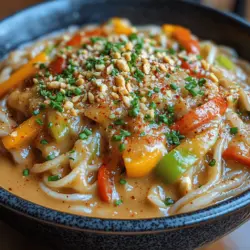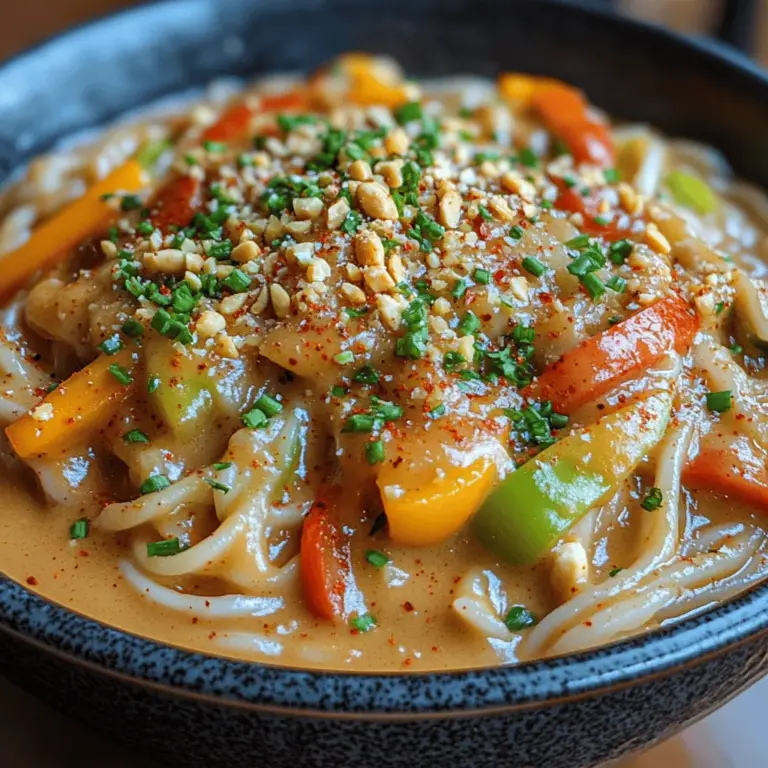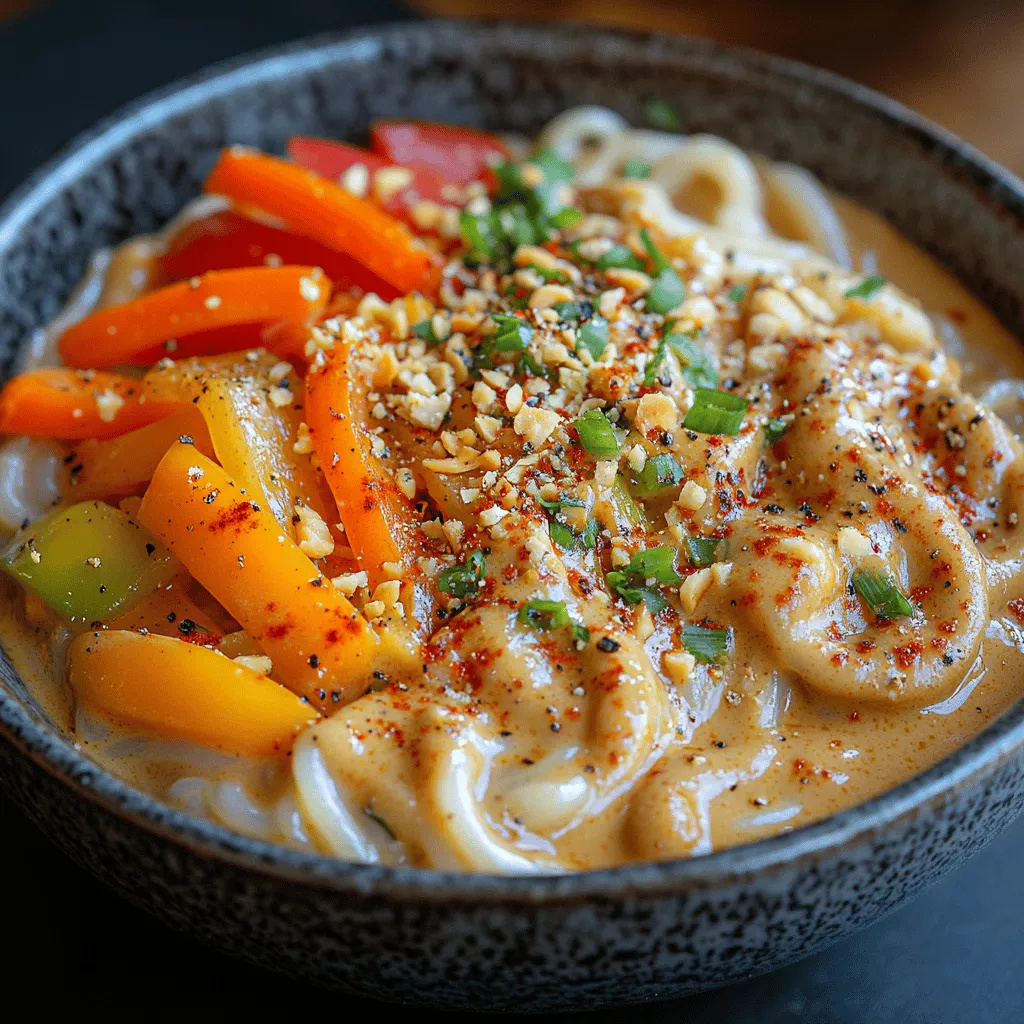Creamy Thai Peanut Noodles: A Culinary Delight
Thai cuisine is celebrated around the globe for its vibrant flavors, aromatic herbs, and colorful presentations. Among the many dishes that have made Thai food a favorite is the Creamy Thai Peanut Noodles. This dish perfectly encapsulates the essence of Thai cooking, combining a rich, savory peanut sauce with tender noodles and a medley of fresh vegetables. The harmony of flavors and textures makes Creamy Thai Peanut Noodles not only satisfying but also a versatile meal that can be enjoyed any day of the week.
The appeal of this dish lies in its creamy, nutty sauce, which is both rich and comforting. Peanut butter, a key ingredient, adds depth and a delightful richness, while the combination of fresh vegetables offers a nutritional boost, making every bite not only flavorful but also wholesome. With the balance of creaminess from coconut milk and the crunch of vegetables, this dish is a celebration of taste that showcases the best of Thai culinary traditions.
Moreover, Creamy Thai Peanut Noodles can be tailored to suit various dietary preferences. Whether you’re a meat lover, a vegetarian, or someone looking to incorporate more plant-based meals into your diet, this dish can be adapted to meet your needs. The use of fresh ingredients not only enhances the flavors but also contributes to a healthier meal, packed with vitamins and nutrients.
Exploring the Ingredients
To create a delicious plate of Creamy Thai Peanut Noodles, it’s essential to understand the main components that contribute to its rich flavor profile. Let’s break down these ingredients, starting with the base of the dish: the rice noodles.
Rice Noodles: Types and Cooking Tips
Rice noodles are the foundation of this dish, offering a light and chewy texture that perfectly absorbs the creamy sauce. There are several types of rice noodles available, including flat, wide rice noodles often used in Pad Thai, and thinner rice vermicelli noodles. For Creamy Thai Peanut Noodles, the wider rice noodles provide a delightful bite and are typically preferred.
Cooking rice noodles is straightforward, but achieving the perfect texture requires attention. Start by boiling a pot of water, and once it reaches a rolling boil, add the rice noodles. Follow the cooking instructions on the package, as different brands may have varying cooking times. Generally, it takes about 5 to 7 minutes for the noodles to soften. Once cooked, drain the noodles and rinse them under cold water to stop the cooking process and prevent them from becoming mushy.
Coconut Milk: The Creamy Base
Coconut milk is another crucial ingredient that contributes to the luxurious texture of the dish. It adds creaminess without the heaviness of dairy, making it an excellent choice for those seeking a plant-based alternative. The high fat content in coconut milk not only enriches the sauce but also enhances the overall flavor profile, providing a subtle sweetness that complements the savory components.
When selecting coconut milk, opt for full-fat varieties for the richest flavor. If you prefer a lighter version, you can use light coconut milk, but be aware that the sauce may not be as creamy. Whichever type you choose, coconut milk is essential for creating a velvety sauce that clings beautifully to the noodles.
Peanut Butter: Smooth vs. Crunchy
Peanut butter is the star ingredient in the creamy peanut sauce, bringing a delightful nuttiness that defines the dish. You can choose between smooth or crunchy peanut butter, each offering a different texture and flavor experience. Smooth peanut butter creates a silky sauce that blends seamlessly with the coconut milk, while crunchy peanut butter adds bits of peanuts for an interesting texture that can elevate the dish.
In terms of nutrition, peanut butter is an excellent source of protein, healthy fats, and essential vitamins and minerals. It provides energy and helps to keep you feeling full, making it a great addition to any meal.
Breaking Down the Remaining Ingredients
In addition to rice noodles, coconut milk, and peanut butter, a few other key ingredients work together to create the perfect balance of flavors in Creamy Thai Peanut Noodles.
– Soy Sauce: Adds a salty, umami flavor that enhances the overall taste of the dish. Opt for low-sodium soy sauce if you’re watching your salt intake.
– Lime Juice: Introduces a bright acidity that cuts through the richness of the peanut sauce, adding a refreshing element.
– Brown Sugar: Balances the flavors with a hint of sweetness, enhancing the taste of the peanut butter and soy sauce.
– Sesame Oil: A small amount of this oil adds a distinctive toasted flavor that complements the other ingredients beautifully.
– Garlic and Ginger: These aromatic ingredients provide a depth of flavor and warmth, making the dish incredibly fragrant.
– Vegetables: Fresh vegetables such as bell peppers, carrots, snap peas, and broccoli not only add color and texture but also provide essential vitamins and minerals.
Step-by-Step Preparation Guide
Now that we’ve explored the ingredients, let’s dive into the preparation of Creamy Thai Peanut Noodles.
Cooking the Rice Noodles
Begin by preparing the rice noodles, as they will be the base of your dish. Bring a large pot of water to a boil, and once boiling, add the rice noodles. Stir occasionally to prevent them from sticking together. Cook according to package instructions, usually around 5 to 7 minutes. You want the noodles to be tender but still firm to the bite, a texture known as “al dente.” Once cooked, drain the noodles in a colander and rinse them under cold water. This step is crucial as it halts the cooking process and prevents the noodles from becoming overly soft.
Crafting the Creamy Peanut Sauce
While the noodles are cooking, you can prepare the creamy peanut sauce. In a medium saucepan over medium heat, combine the coconut milk and peanut butter. Using a whisk, stir until the peanut butter is fully incorporated into the coconut milk. It’s important to whisk thoroughly to ensure a smooth consistency. As the mixture heats, add soy sauce, lime juice, brown sugar, and sesame oil. Continue to whisk until the sauce is well blended and heated through. This process not only helps develop the flavors but also creates a creamy texture that will envelop the noodles.
Sautéing the Vegetables
Next, it’s time to sauté the vegetables. Heat a tablespoon of oil in a large skillet or wok over medium-high heat. Add minced garlic and grated ginger, stirring quickly to release their flavors without burning. Then, add your choice of chopped vegetables. Colorful bell peppers, crisp carrots, and tender broccoli are excellent choices, but feel free to mix in any vegetables you have on hand. Stir-fry the vegetables for a few minutes until they are just tender, but still retain some crunch. This technique helps to preserve their vibrant colors and nutrients, adding both visual appeal and health benefits to your dish.
With the noodles cooked, the sauce perfected, and the vegetables sautéed, you will be ready to combine all the components into a delicious dish that showcases the best of Thai flavors. Stay tuned for the next part of this article, where we will explore how to assemble your Creamy Thai Peanut Noodles and serve them for an unforgettable meal.
Combining Noodles and Sauce
Once your noodles are cooked to perfection, it’s time to bring everything together for an explosion of flavors. Begin by draining the noodles in a colander and rinsing them briefly under cold water to prevent them from sticking together. This step is essential, especially if you are using rice noodles, which can clump easily.
Next, in a large mixing bowl, combine the cooked noodles with the prepared creamy peanut sauce. Use a spatula or tongs to gently toss the noodles in the sauce, ensuring every strand is coated evenly. The creamy texture of the peanut sauce should envelop the noodles, creating a rich, inviting dish.
After mixing in the sauce, add your choice of sautéed vegetables. Bell peppers, carrots, and snap peas work beautifully, adding both color and crunch. Toss everything together until the vegetables are well-distributed. If you like a bit of heat, consider incorporating a sprinkle of red pepper flakes or freshly chopped chili peppers at this stage.
Tips on Adjusting Sauce Thickness and Flavor Balance
If you find that your sauce is too thick, you can easily adjust it by adding a splash of water or vegetable broth. Stir it in gradually until you reach your desired consistency. Conversely, if the sauce is too thin, let it simmer on low heat for a few minutes to thicken it up. Taste your dish as you go, adjusting the balance of flavors as needed. You may want to add a bit more soy sauce for saltiness, a dash of lime juice for acidity, or a spoonful of sugar to enhance sweetness. This is your culinary creation, so feel free to tailor it to your palate.
Serving Suggestions
Presentation can elevate any dish, and Creamy Thai Peanut Noodles are no exception. For an appealing bowl presentation, serve the noodles in a deep bowl, allowing the colors of the vegetables to pop against the rich sauce.
Ideal Garnishes
Garnishing is not just for aesthetics; it adds layers of flavor and texture. Consider topping your noodles with:
– Chopped Green Onions: Their mild onion flavor complements the nuttiness of the sauce.
– Fresh Cilantro: Adds a burst of freshness and vibrancy.
– Crushed Peanuts: For added crunch and a hint of saltiness.
– Red Pepper Flakes: To kick up the heat for those who enjoy a little spice.
Ideas for Serving
This dish is incredibly versatile. You can serve it as a main course or as a side dish alongside proteins like grilled chicken, shrimp, or tofu. If you want to make it a complete meal, consider pairing it with a light salad or spring rolls.
Nutritional Benefits of Creamy Thai Peanut Noodles
Creamy Thai Peanut Noodles not only tantalize your taste buds but also pack a nutritional punch.
Analysis of Macro and Micronutrients
This dish is rich in carbohydrates from the noodles, healthy fats from peanut butter and coconut milk, and proteins if you choose to add chicken or tofu. The vegetables contribute essential vitamins and minerals, making it a well-rounded meal.
– Carbohydrates: Provide energy, perfect for a post-workout meal.
– Proteins: Essential for muscle repair and growth, especially if you add tofu or chicken.
– Fats: Healthy fats from peanut butter and coconut milk support brain health and hormone production.
Benefits of Coconut Milk and Peanut Butter
Coconut milk is a fantastic source of medium-chain triglycerides (MCTs), which can offer quick energy and may support weight loss. Peanut butter is rich in protein and healthy fats, helping to keep you satiated and energized.
Importance of Incorporating Fresh Vegetables
Adding fresh vegetables not only elevates the dish’s nutritional profile but also enhances its texture and flavor. Vegetables like bell peppers and carrots are high in vitamins A and C, contributing to overall health and wellness.
Customization and Variations
One of the best aspects of Creamy Thai Peanut Noodles is their versatility.
Making the Dish Vegan or Gluten-Free
To make this dish vegan, ensure you use a plant-based peanut butter and substitute soy sauce with tamari for a gluten-free option. Rice noodles are generally gluten-free, making this a perfect choice for those with dietary restrictions.
Additional Ingredients
There are countless ways to customize your Creamy Thai Peanut Noodles:
– Protein Options: Add grilled chicken, shrimp, or tofu for extra protein.
– Alternative Veggies: Broccoli, zucchini, or spinach can also work well.
– Spice Levels: Adjust the heat by adding more chili paste or fresh chilies according to your preference.
Meal Prep and Storage Tips
If you’re making this dish for meal prep, store it in airtight containers. The noodles can be kept in the refrigerator for up to three days. When reheating, add a splash of water or broth to loosen the sauce, ensuring it doesn’t dry out.
Cultural Significance of Thai Cuisine
Thai cuisine is celebrated for its rich flavors and balanced ingredients. A brief insight into its history reveals diverse influences from China, India, and Malaysia, resulting in a unique culinary identity.
Introduction to Thai Flavors and Ingredients
Thai dishes often feature a harmonious balance of sweet, salty, sour, and spicy flavors. Ingredients such as lemongrass, galangal, and Thai basil are staples that showcase the vibrant taste of Thailand. Peanut sauce, with its creamy and nutty profile, is a perfect representation of Thai culinary tradition.
Importance of Balance in Thai Cooking
The essence of Thai cooking lies in achieving balance. The interplay of flavors creates depth and complexity in dishes. For example, the sweetness of coconut milk and peanut butter balances the heat from chilies and the acidity from lime juice, resulting in a symphony of tastes.
Conclusion
Creamy Thai Peanut Noodles are an accessible yet delicious way to bring a taste of Thailand into your home. This dish is not only easy to prepare but is also a canvas for creativity and personalization, encouraging culinary experimentation.
Whether you prefer it spicy or mild, packed with protein or loaded with fresh vegetables, this recipe caters to your taste. Embrace the flavors of Thai cuisine and make Creamy Thai Peanut Noodles a staple in your kitchen. Enjoy the journey of flavors and the satisfaction of creating a delightful meal that can easily become a family favorite.



